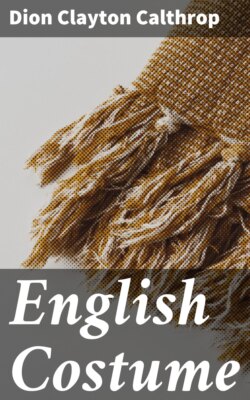Читать книгу English Costume - Dion Clayton Calthrop - Страница 32
На сайте Литреса книга снята с продажи.
THE COUNTRY FOLK
ОглавлениеTable of Contents
From the Conquest to the reign of Edward I.
Until the present day the countryman has dressed in a manner most fitted to his surroundings; now the billycock hat, a devil-derived offspring from a Greek source, the Sunday suit of shiny black with purple trousers, the satin tie of Cambridge blue, and the stiff shirt, have almost robbed the peasant of his poetical appearance.
Civilization seems to have arrived at our villages with a pocketful of petty religious differences, a bagful of public-houses, a bundle of penny and halfpenny papers full of stories to show the fascination of crime and—these Sunday clothes.
The week’s workdays still show a sense of the picturesque in corduroys and jerseys or blue shirts, but the landscape is blotted with men wearing out old Sunday clothes, so that the painter of rural scenes with rural characters must either lie or go abroad.
As for the countrywoman, she, I am thankful to say, still retains a sense of duty and beauty, and, except on Sunday, remains more or less respectably clad. Chivalry prevents one from saying more.
In the old days—from the Conquest until the end of the thirteenth century—the peasant was dressed in perfect clothes.
The villages were self-providing; they grew by then wool and hemp for the spindles. From this was made yarn for materials to be made up into coats and shirts. The homespun frieze that the peasant wore upon his back was hung by the nobleman upon his walls. The village bootmaker made, besides skin sandals to be tied with thongs upon the feet, leather trousers and belts.
The mole-catcher provided skin for hats. Hoods of a plain shape were made from the hides of sheep or wolves, the wool or hair being left on the hood. Cloaks lined with sheepskin served to keep away the winter cold.
To protect their legs from thorns the men wore bandages of twisted straw wrapped round their trousers, or leather thongs cross-gartered to the knee.
The fleece of the sheep was woven in the summer into clothes of wool for the winter. Gloves were made, at the beginning of the thirteenth century, of wool and soft leather; these were shaped like the modern baby’s glove, a pouch for the hand and fingers and a place for the thumb.
A coarse shirt was worn, over which a tunic, very loosely made, was placed, and belted at the waist. The tunic hardly varied in shape from the Conquest to the time of Elizabeth, being but a sack-like garment with wide sleeves reaching a little below the elbow. The hood was ample and the cloak wide.
The women wore gowns of a like material to the men—loose gowns which reached to the ankles and gave scope for easy movement. They wore their hair tied up in a wimple of coarse linen.
